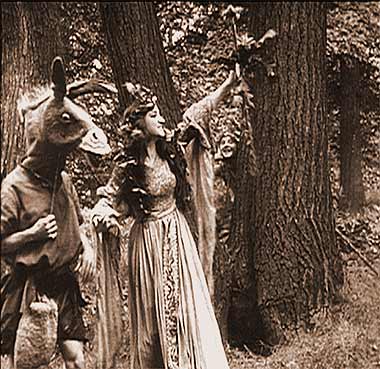
Vitagraph 7 continued from page 6
 |
"Well, this is the forest of ... Brooklyn." A still from A Midsummer Night’s Dream, with William Ranous as Bottom and (probably) Florence Turner as Titania, in the chestnut woods of Greenfield. (Courtesy of Milestone Film & Video www.milestonefilms.com.) |
The next film, Romeo
and Juliet, also enjoyed high praise; even quieting the censor, who
declared that "the love element, not the fight element, predominates . . .
So love is the feature of the Romeo and Juliet films, and love is
fit for children to see, if kept within reason." Ranous next took on the
role for which Salvini was famed, Othello, but an odd silence shrouds this
picture. That it equalled the preceding productions is suggested by a
review of the next film, Richard III, which was hailed as "equal
to the other three Shakespeare films which have been put out by this
company." Antony and Cleopatra enjoyed some of the greatest
acclaim yet; not so Julius Caesar, notable for its almost exact
reproduction in three dimensions of Jean Leon Gerome's painting, The
Death of Caesar, and for a dog who strayed onto the
set during Marc Antony's funeral oration, perhaps having taken too
literally Antony's line, "Cry 'Havoc!' and let slip the dogs of war." He
ruined 200 feet of film.
The Merchant of
Venice, shot mostly in front of painted backdrops, fared more poorly
still in critical acclaim; King Lear, set similarly and reviewed similarly, was
the last of the films produced in Vitagraph's Shakespearean fever. It
would be nine months before a new Shakespeare film came from the studio.
It was worth the wait.
Though filmed in midsummer,
Vitagraph held up release of A Midsummer Night's Dream until
Christmas Day, which may have been the best of the Shakespeare films made
by this—or any—studio of the silent era. No small measure of its
success may be that, unlike the earlier films, and especially the last
three which did so poorly, "it was [in the words of Robert Ball in
Shakespeare on Silent Film] more of a movie than a photograph of a play." Filmed almost entirely
outdoors, the actors "move through scenery which seems more varied than it
is, and . . . blend in with the sylvan mystery of light and shade. The
result is that the film does achieve a kind of pictorial poetry
appropriate both to the fairy atmosphere and the lunacy of the
lovers."
The stock company shined. The first
matinee idol, former stage actor
and vaudevillian Maurice (Dimples) Costello, was Lysander, Ranous played Bottom, the
Titania was probably Florence Turner (credits were yet to be given in films),
but the scene stealer was 13-year-old Gladys Hulette as Puck. All told, compacted though it was,
shorn of the text, critics on both sides of the Atlantic felt
that Shakespeare hadn't suffered a bit. Indeed, a New York reviewer said the film
produced "a continuous and intelligible story which does not destroy the narrative—which
makes the narrative clear, even to a moving picture audience."
From London: "Students of the great dramatist's works will thoroughly enjoy the careful pictorial representation of
the many scenes, while the whole play is so cleverly portrayed that it will not
fail to delight the spectator who is not familiar with the
works of Shakespeare."
©2000 The Composing Stack Inc. All rights
reserved.
urbanography is a service mark of The Composing Stack
Inc.
Updated June 25,
2000.